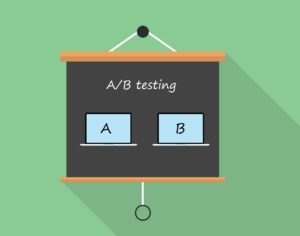
No matter how much time and energy we put into our marketing efforts, not every campaign gets positive results. A/B testing is a simple yet effective technique to ensure you use the right messaging to reach your audience and drive desired outcomes. It can be used to evaluate anything from email copy to website content. A/B testing helps marketers determine the best-performing version of their messaging before launching a campaign that falls flat. One simple A/B test can generate data-driven insights that boost traffic, drive more leads and improve the overall performance of your marketing efforts.
What Is A/B Testing?
A/B testing, also known as split testing, is a process that compares two or more variations of a marketing element to determine which one performs better. These elements can include email subject lines, website landing pages, ad copy, call-to-action buttons, and social media posts. In an A/B test, two versions of the same asset are randomly shown to different groups. For example, group A might see a call-to-action button that reads, “Download Now” and group B sees a button that says, “Download This Free Guide.” After a certain period of time, compare conversion rates to see which graphic generated the most clicks.
Six Tips for A/B Testing
If you’re not taking advantage of a few simple A/B testing tactics, you could be missing out on potentially significant improvements to your marketing campaigns. Here are some tips for successful A/B testing:
1. Test multiple variables.
Don’t limit yourself to only testing the obvious variables, like an email subject line. A/B testing can be used to evaluate the elements like color, image size, special offers, templates, layout, timing and frequency. The more elements you test, the better you’ll be able to find out what works, refine your marketing tactics, and generate positive results.
2. Test one element at a time.
Experienced A/B testers know it’s essential to focus on just one variable for each A/B test. Testing several variables simultaneously can lead to confusion and makes it difficult to isolate why one element worked better than the other. Don’t play the guessing game when it comes to A/B testing. Test one element at a time so the data can speak for itself.
3. Wait to evaluate the results.
When you run your first A/B test, it may be tempting to declare a winner as soon as you see results. But A/B testing is not just about seeing which headline, subject line or image performs better. It’s about discovering why your audience prefers one over the other and that can take more than a day or two to get the most accurate data. Depending on your marketing channel and variable, consider testing for several weeks before adjusting your tactics.
4. Test on multiple channels.
The marketing channels you can use to A/B test your variables are nearly endless. Consider where your audience engages with your content and how they might react to different versions of your message. Channels such as emails, landing pages, websites, organic social media posts, Google PPC ads and sponsored LinkedIn ads are all possibilities for testing. In addition to discovering which elements work best on which channels, you will also discover which marketing mediums your audiences prefer to use to engage with you.
5. Make changes based on the results.
After you conduct A/B tests and analyze what elements performed best and why, it’s time to make adjustments. Refine your marketing tactics on all channels based on what you learned from A/B testing. These adjustments could be sending emails at a different time, changing the color of an advertisement or incorporating new messaging on a landing page. As you get into the habit of regular A/B testing, you might be surprised at how the performance of your marketing efforts improves. You’ll also be more connected to your audiences than ever before, seeing firsthand what resonates with them.
6. Perform continuous testing.
If you’re not A/B testing consistently, you’re missing out on valuable opportunities to improve your marketing results. Don’t be afraid to try new things with the understanding that some campaigns, variables or messages won’t work. The important part is to keep experimenting and learning what performs best for your audience.
A/B Test for Continuous Improvement

Well-executed A/B tests can make an enormous difference in the effectiveness of your marketing programs. Identifying and combining the most successful elements of a promotion increases engagement, improves conversions, boosts ROI and strengthens relationships with target audiences. A/B testing is an iterative process. As you gain insights and implement winning variations, you can refine your marketing efforts over time, leading to sustained improvement and growth.
If you want to make sure you’re working toward success and improving your marketing efforts, don’t guess. A/B test it! Want to talk with one of our experts about creating marketing messaging that resonates with your target audiences? Schedule a meeting with one of our experts.
